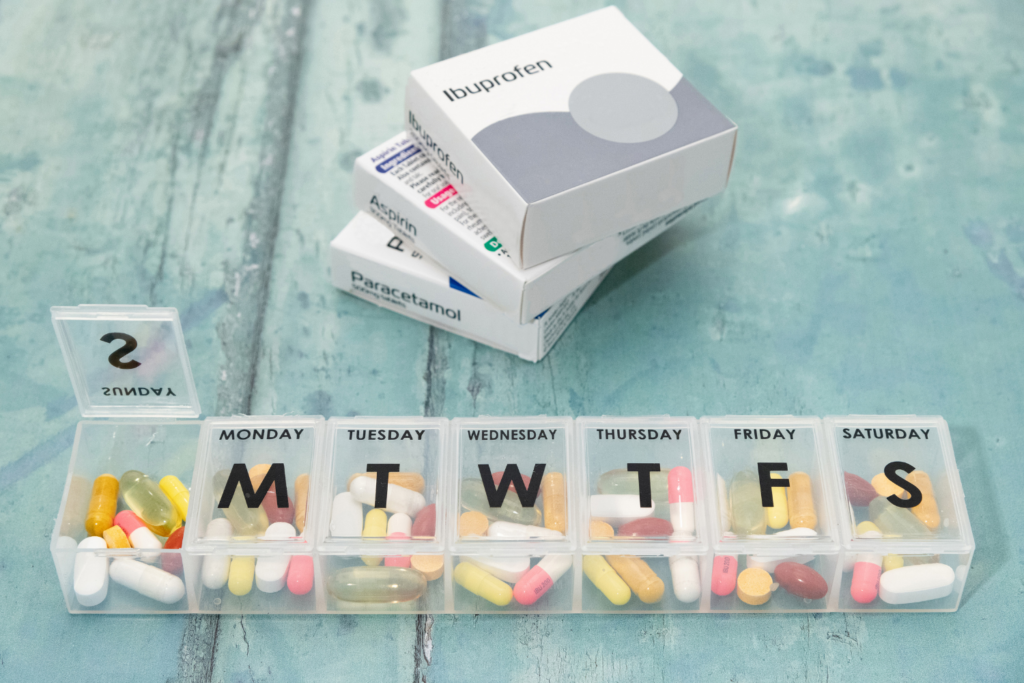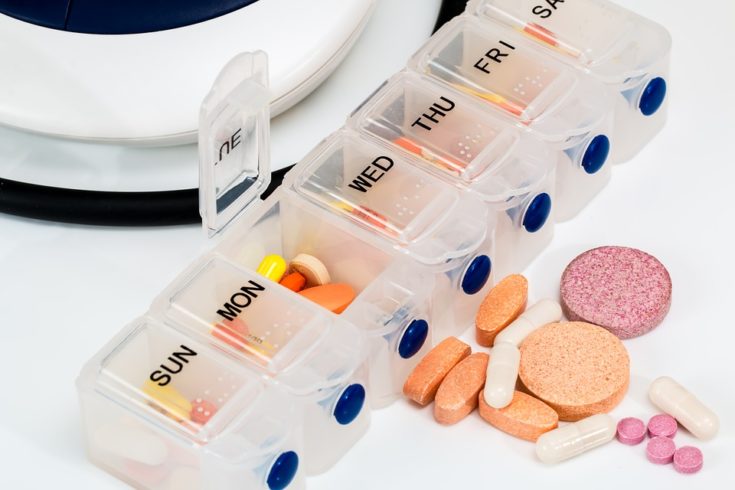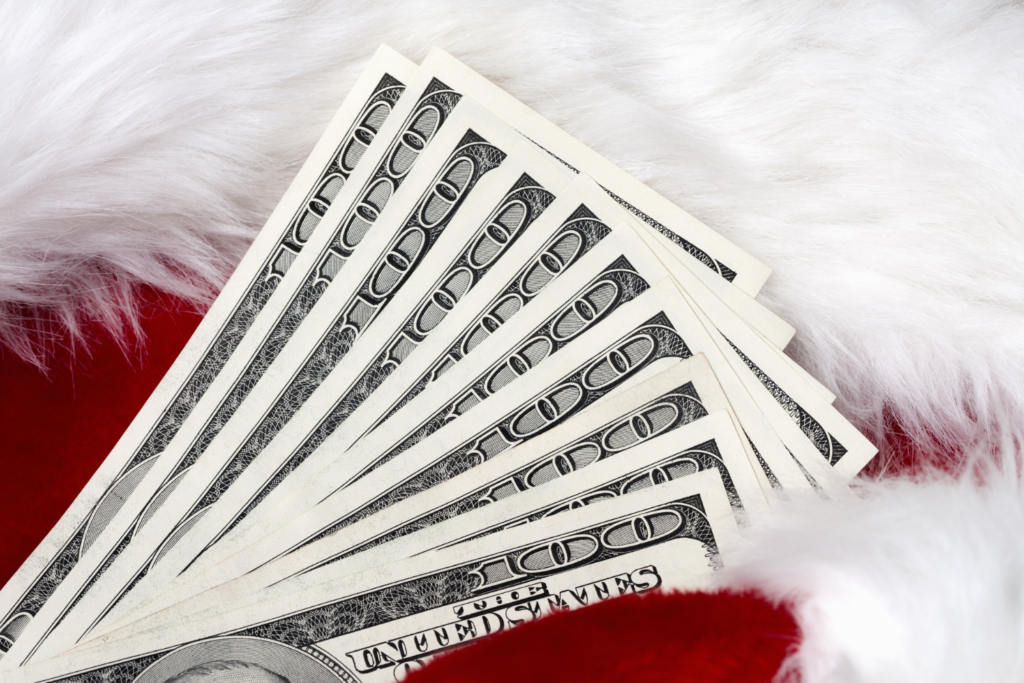
Even if you have health insurance, prescription discount cards, and/or a health savings account (HSA), the price of some prescription medication can still cause sticker shock. Just last week, I went to pick up two medication refills. The pharmacy tech told me the total price would be over $773.98! After applying just one of my tips below, I was able to get the final price down to $32.66 in under 5 minutes. That made me happy. But three things about the whole situation made me very unhappy.
- The fact that the original cost of the medication is super expensive to begin with.
- The fact that until recently pharmacists couldn’t tell you that medication could be potentially cheaper.
- The fact that most people don’t know there are ways to save money so just pay the original cost.
Therefore, I want to help you and your loved ones save money on your next trip to the pharmacy. Don’t worry, this post isn’t going to be about how you should eat right and exercise so you don’t need to take medication, although that would probably help me alleviate the medication that I take for high blood pressure! This post is about the ways I have personally saved money on life-saving needed medications for myself and my loved ones.
Contents
- 18 Ways To Save On Prescription Medication
- 1. Free Samples
- 2. Generics
- 3. 90-Day Supply
- 4. Split Pills
- 5. Free Antibiotics
- 6. Mail-Order
- 7. Coupons, Vouchers & Rebates
- 8. Discount Cards & Apps
- 9. Patient Assistance Programs
- 10. Medicaid
- 11. Obamacare
- 12. The Assistance Fund
- 13. Cash Price
- 14. HSA
- 15. FSA
- 16. Online Drugstores
- 17. Cross The Border
- 18. Experimental Drugs
- Conclusion
18 Ways To Save On Prescription Medication
1. Free Samples
While at the doctor’s office, ask if they have any samples of the drug you’ve been prescribed. Many times, drug reps will leave samples of the higher-priced medications in hopes the doctor will prescribe them. If you forgot to ask while at the clinic, call and ask the nurse. Most often the drug reps leave the lowest dose of the medication as that is the most common starting dosage. If you take a higher dosage, you may need to take two or more of the samples to get your needed dose strength.
2. Generics
Pharmaceutical patents currently last for 20 years from the date of the application. During this time, only the name brand prescription is available from the patent-holding manufacturer, thus the extremely high price of new drugs. Once the patent time has passed, other manufacturers can bank in, and the more manufacturers, the lower the price goes. These are considered generic medications, and in most cases work as well as the original brand name and are available at a fraction of the price. So if your medication is priced exorbitantly high, ask your pharmacist if a generic is available for less.
3. 90-Day Supply
Some commercial and group plan insurances offer what I consider a BOGO offer, i.e. Buy two months get one free. So if your drug is normally $10 per month. Ask for a 90-day supply (3 months) which will cost $20, saving you $10. You may need to ask your prescriber to re-write the prescription if your pharmacist doesn’t ask for you.
4. Split Pills
More often than not, you can get a higher dose of the same medication at the same price or slightly more than the cost of the dose you need and then simply cut the tablet in half. You can ask your pharmacist to cut the pills in half or invest in an inexpensive pill cutter. This does not work though if your medication is in capsule form or is a coated pill, and time-released drugs should be taken as a whole. If the prescriber writes the prescription for the higher dose and doesn’t specify to only take half (which may be considered unethical), you then only need to pay for your Rx every other month.
5. Free Antibiotics
Some national and regional chain pharmacies actually offer free medications with a valid prescription with no insurance needed and no obligation to buy anything further. Of course, they are hoping you’ll buy something else once they get you in the door.
Pharmacies That Offer Free Antibiotics
Below are the retailers in alphabetical order that offer free antibiotic medications (and some other free drugs). Click on each link to see the exact medications that you can get for free.
- Meijer (select antibiotics and prenatal vitamins)
- Midtown Pharmacy (Wisconsin)
- Reasor’s (select liquid antibiotics for children under the age of 12)
- Sam’s Club (select generic medications for Sam’s Club Plus members)
- Super 1 Foods (Mississippi, Louisiana, Texas)
- Winn-Dixie (select antibiotics and diabetic medications)
6. Mail-Order
Other commercial and group plan insurances may only offer the “BOGO” rate if you order through their mail-order pharmacy. The mail-order prices are usually less expensive than your local pharmacy and are good for maintenance drugs that you will be on long-term. But if you need a prescription right away, this is not a good option. Regular shipping is usually free, but express shipping fees are outrageous, so always be sure to request a refill in plenty of time before needed as in my experience, it takes about a week to receive your medications in the mail. Sometimes it may even be longer if they need to get approval from the doctor first to refill.
7. Coupons, Vouchers & Rebates
If you were prescribed a newer drug, chances are that it is super expensive, but the chances are good that they also offer free samples and a coupon or voucher to reduce the price and in some cases, offer it totally free to new users. So if your insurance doesn’t cover a certain medication or you have a high-deductible, I recommend googling the prescription medication name plus the word coupon or voucher, i.e. “drug name coupon”. Look for a search result that brings you directly to the drug or manufacturer website as you don’t want to click on any advertisements offering to sell you anything.
Here is an example of a drug I recently googled “Vyvanse coupon”.

You’ll need to register for the “savings card”. In this case, you can choose a mobile savings card or a PDF printable card. Unfortunately, this Vyvanse coupon is a not great deal if you read the fine print as Vyvanse costs several hundreds of dollars per month.
*Pay as little as $30 per prescription of Vyvanse (lisdexamfetamine dimesylate) for a maximum of up to $60 savings per prescription. The offer covers the amount above $30 up to a maximum of $60 savings per prescription. You will be responsible for any additional cost above $90 for each prescription.
Another better example is “Austedo coupon” (yes, I have a lot of experience in saving money on mental health drugs).

Austedo offers new patients their first prescription free, and $0 copays per month for refill prescriptions. The fine print says you must have commercial insurance for this offer (State or federal-funded healthcare programs, uninsured and cash-paying customers are excluded). But this is a great program if you have a high-deductible as the actual cost (which is upwards of a thousand per month) goes towards your deductible, and you seriously pay zero dollars!
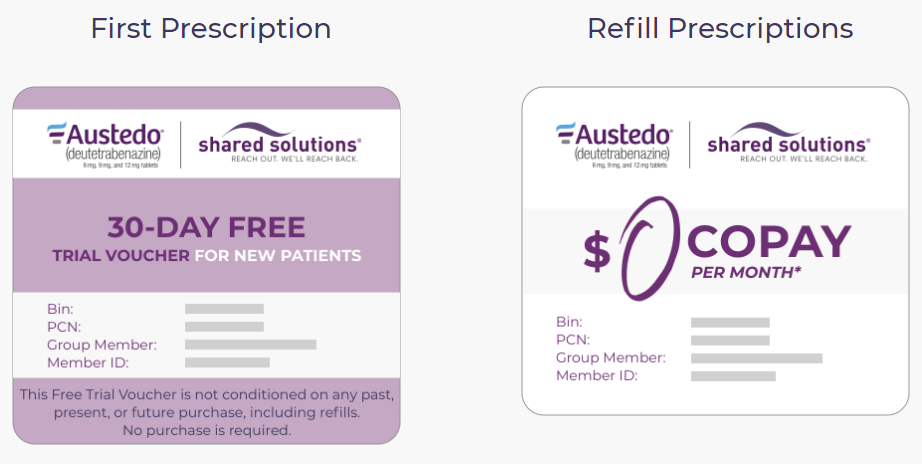
Prescription coupons, vouchers, and savings cards all have an expiration date. If you got from the doctor’s office it may have a random date. But most last for a year from the initial date and others expire at the end of the year. So, be sure to set a reminder if you will need to take long term.
You may also want to set up a Google Alert to be notified if new coupons, vouchers or savings cards are available for a specific medication.
8. Discount Cards & Apps
Free prescription discount cards vary from savings cards as they cannot be used with insurance and are good on most medications, not just one specific one. There are several available – you may have even seen cards for them available at doctor’s offices, physician’s clinics, and even pharmacies for the taking.
Free Prescription Discount Card Services
- Blink Health
- GoodRx
- RxSaver (more on this one later)
- SingleCare
- WellRx (this is the card I used above to save $741.32)
You can use most of the above free prescription discount services with no registration needed. You can also print off cards from the respective websites or download their app on your mobile.
The most popular prescription discount card is GoodRx.
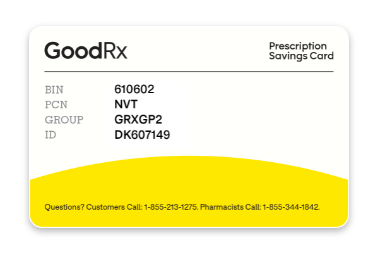
Use this card for discounts of up to 80% on most prescription drugs at over 70,000 U.S. pharmacies. Get discounts for every member of your family, including pets! No expiration. No fees or obligations. No credit card required. GoodRx is not insurance. Savings based on pharmacy retail price.
If I have time, I will actually compare prices on all of the sites/apps to see which will get me the best deal and save me the most money.
9. Patient Assistance Programs
Most pharmaceutical companies offer some sort of patient assistance program (PAP) for those that qualify for financial assistance. There is some paperwork that needs to be done by both you and the prescribing physician, and most likely you will need to provide proof of income, either pay stubs or tax returns. The income limits are usually quite high compared to the poverty level (as the poverty level should qualify one for government assistance).
Let’s circle back to saving money on Vyvanse. Takeda (the manufacturer of Vyvanse) provides the Help At Hand Patient Assistance & Support Program to assist patients with limited financial resources.
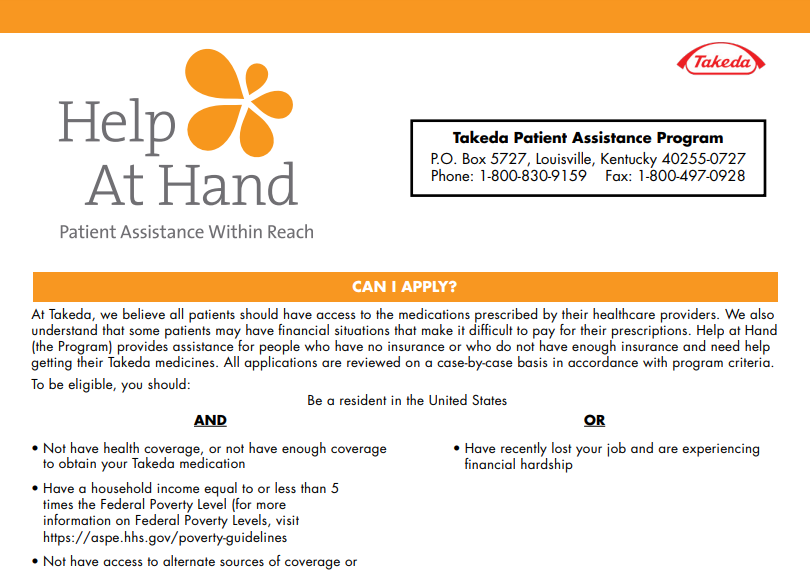
As you can see by the Help At Hand patient assistance program, you can qualify for patient assistance if you do not have health insurance or not enough coverage (such as high deductible), have a household income equal to or less than 5 times the Federal Poverty Level, and not have access to alternate sources of coverage, or have recently lost your job and are experiencing financial hardship.
If you qualify, you should then receive the medication you need at no cost for either a full year or until the end of the year when you would need to reapply. The patient assistance program may send you your medication through the mail from their chosen pharmacy provider, or they may send the prescription to your doctor’s office for you to pick up, or they may give you a different savings card uniquely to you that will give you a $0 copay at your local pharmacy.
10. Medicaid
If you have fallen on hard times, please do not be too proud to apply for government assistance. When my twins were born prematurely back in 1994, we maxed out the lifetime spend that our insurance would payout. Had we not received Medicaid for the twins, we probably would’ve had to claim bankruptcy as there was no way we could afford millions of dollars worth of medical bills. My grandma told me, “I pay my fair share of taxes. I hope someone I know can benefit from them that needs help” and we needed help.
Medicaid eligibility varies from state to state. If you google “your state Medicaid”, replacing “your state” with the state that you live in, you should find a link for your state Medicaid agency with a link for an application as well as requirements to qualify. You can also now apply for Medicaid at Healthcare.gov.
11. Obamacare
The Government Healthcare Marketplace has been dubbed “Obamacare” because the Affordable Care Act was signed into law by President Barack Obama in 2010. You don’t have to be an Obama supporter or even a Democrat to take advantage of this healthcare reform.
In my humble opinion, there are good things and bad things about Obamacare. The good is that none of the health insurances offered in the Marketplace can have existing condition clauses. The bad is that that then increases the cost of health insurance for those of us that can afford it and don’t qualify for subsidies.
So if you don’t currently have health insurance, I do recommend that you at least look at the options that the Marketplace has to offer. I currently have health insurance through there.
12. The Assistance Fund
The Assistance Fund is a nonprofit organization that provides financial assistance for patients facing high medical out-of-pocket costs (including prescription medications) for certain medical conditions. See medical conditions covered here. Once you apply, they try to approve you within 24 hours.
13. Cash Price
Ask if the cash price of your medication is less than if they ran the prescription through your insurance. More often than not, it is. Most pharmacies, including Walmart and Target, have a long list of “$4 drugs” where you pay $4 for a 30-day generic medication and $10 for 90-day prescriptions. If you have a high deductible, paying the cash price will not go towards your deductible so you need to weigh your options if the cash price is not much less.
14. HSA
HSA, which stands for Healthcare Savings Account, is a tax-advantaged medical savings account that is available to United States taxpayers who are enrolled in a High Deductible Health Plan (HDHP). The funds that you contribute to an HSA account are not subject to federal income tax at the time of deposit. You can then use those untaxed dollars to pay for copays, deductibles, dental work, contact lenses, and other qualified expenses. Health insurance premiums do not count as a qualified expense. There is an annual cap on how much money you can contribute each year, and if you don’t spend it, it will accrue interest and can use as a retirement account.
If your bank is charging you a service fee on your HSA, get a different bank as you are likely paying more in service fees than you are earning in interest. Many banks offer free HSA accounts.
15. FSA
Flexible Savings Accounts (FSA) is similar to an HSA yet totally different. FSA are sponsored by employers, so one must be an employee of a participating employer. The funds (also capped) contributed are deducted from earnings and not subject to taxes. Fund withdrawn for medical care are not subject to tax either, but if you do not use the entire amount you contributed throughout the year by the end of the year, you lose that money – it does not roll over to the next year! Unused FSA money returns to your employer.
I personally do not recommend using a medical-related FSA for healthcare unless your employer is contributing to it in some way and you are 100% certain that you will spend the amount you have saved before the end of the year. A medical-related FSA is different than a dependent-care FSA which I may recommend for childcare costs.
16. Online Drugstores
Billionaire entrepreneur Mark Cuban recently launched the Mark Cuban Cost Plus Drug Company (MCCPDC) which is an online pharmacy that offers over 100 affordable life-saving medications. The company cuts out the pharmacy middlemen and negotiates directly with the pharmaceutical manufacturers to get the best possible prices. They do not accept any insurance but claim that in most cases, even without insurance, their prices are less than what you would pay with insurance at your local pharmacy.
Online Pharmacy Advice
If you are looking into other online pharmacies, here is a checklist to make sure the online drugstore is legitimate.
- Verify that the seller is on NABP (National Association of Boards of Pharmacy).
- Make sure the website lists a physical street address and look the address up on Google maps to make sure there really is a pharmacy there.
- If the pharmacy does not require a prescription, it is not legitimate.
- Ask if you can speak with a licensed pharmacist. If you can’t, don’t order through them.
17. Cross The Border
I’ve read that prescription medications in both Canada and Mexico* are cheaper than they are in the United States. You can attain these by actually crossing the border or via mail-order pharmacies based in those countries. But keep in mind that it is technically illegal to personally import drugs, so your purchases may be seized by the government.
But if you’re feeling risque, PharmacyChecker.com compares drug prices among verified international and Canadian online pharmacies to find you the lowest price.
*When we were in Cancun, Mexico in January 2023, Ted had a gout flareup and I got seasick on a a boat ride to the island of Isla Mujeres. Even though the boat captain warned us not to buy anything at the first shop we visited as we would be able to find it cheaper if we shopped around, Ted and I went to the first pharmacy we saw and got gout medication for him and a Zofran equivalent for me (we googled the medication names to make sure we were getting treated correctly). We paid about $100 for the two medications which we though was not cheap at all, but they did help our ailments.
**Update, after our return, UCLA Health published an article about how counterfeit pills sold in Mexican pharmacies were found to contain fentanyl, heroin, and methamphetamine! The pills affected were equivalents of controlled substances such as Adderall, Oxycodone and Percocet, so I think we were safe with our gout and anti-nausea meds, but that’s a scary thought nonetheless.
18. Experimental Drugs
The U.S. Food & Drug Administration has an Expanded Access (also called Compassionate Use) program that may help people with a life-threatening or serious disease gain access to investigational (experimental) medical products which includes drugs, biologics, or medical devices. Obviously, this would be the last resort.
Conclusion
Wow, I ended up with more ways to save money on prescription medications than I realized I would. If just one person can save money by using one of these tips, I will be happy that I was able to help.
On a side note, when I started making websites eons ago, I bought the domain name RxSaver.net and actually had intentions of using it to help others save on prescription medication by having a directory of medications along with specific links to coupons, vouchers, and patient assistance programs for each medication listed. I owned that domain for nearly 20 years but stopped updating it when Google changed their algorithm not liking websites that spoke of pharmaceuticals and it became too cumbersome to keep updating when no one was benefiting from it.
Imagine my surprise in 2018 when I decided to actually let the domain name go and stop paying the yearly registration fee and I see a commercial on TV for RxSaver by RetailMeNot! It isn’t exactly what my vision was but instead compares prices at the major pharmacies and offers their own savings discount card. After reading Clark’s RxSaver review, I can’t say I recommend them.
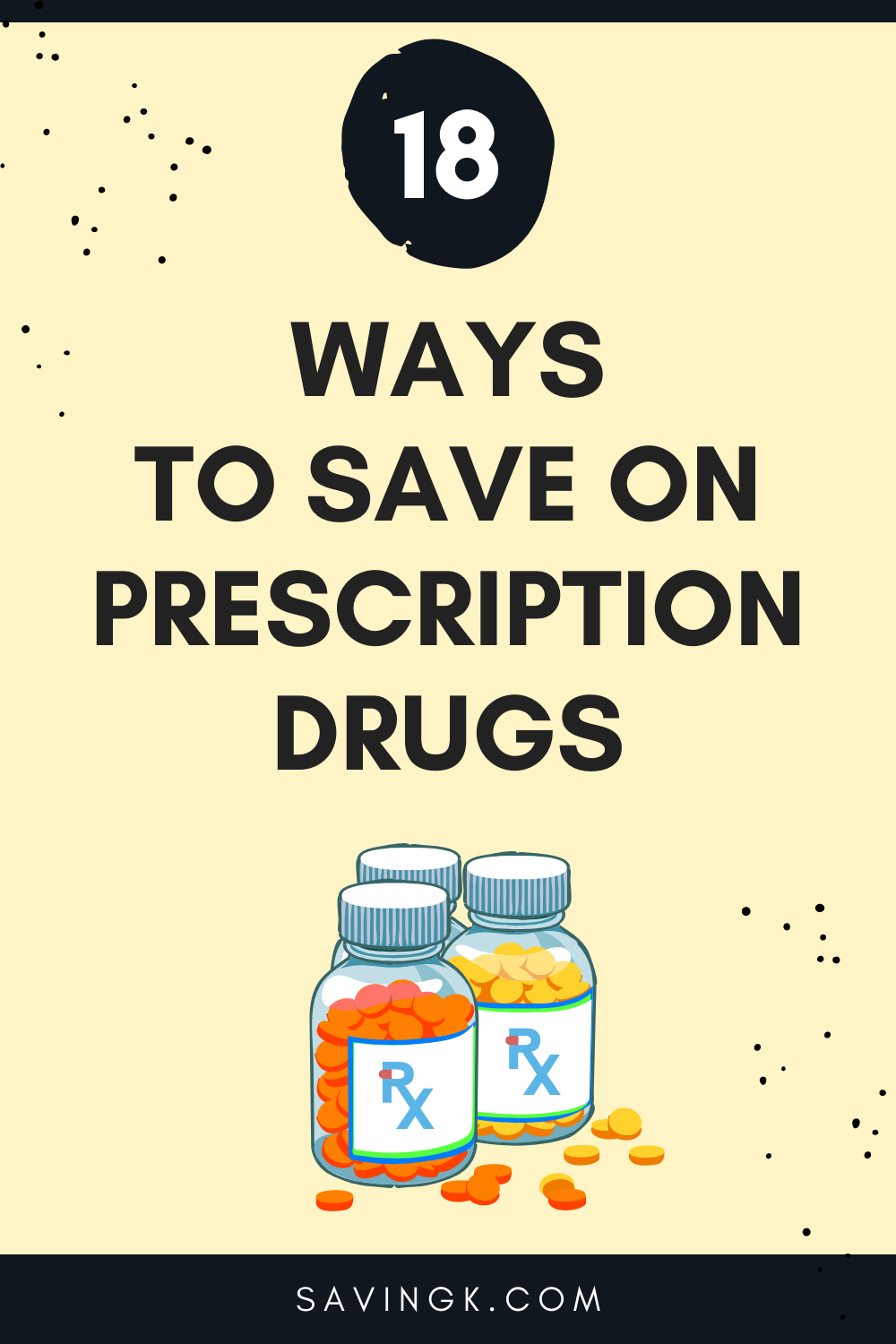
- How Health Affects Wealth: A Case Study Of A Pinched Nerve - July 2, 2024
- Exploring The Different Types Liquidation Businesses - June 20, 2024
- Google SERP Update of March 2024 Unkind To Bloggers - May 20, 2024
